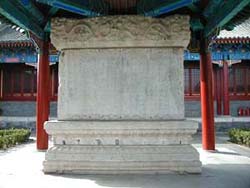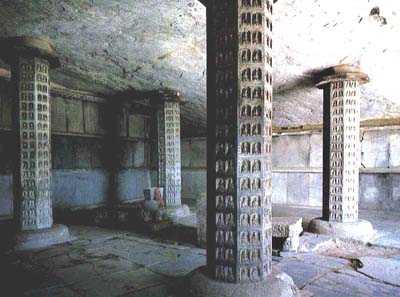The Yunju Temple Stone-Carved Scriptures Exhibition Hall is located in Yunju Temple, at the foot of Mount Baidai, in Fangshan District in the southwestern suburbs of Beijing, 70 kilometers from downtown. It is famous for its 14,278 stone slabs carved with the Buddhist scriptures known as the Tripitaka.

Yunju Temple was built in the late Sui (581-618) and early Tang (618-907) dynasties. It was founded for storing the scriptures carved on stone slabs by a monk named Jingwan. The name Yunju Temple was found on a stone inscription dating from 669, the second year of the Zongzhang reign of the Tang Dynasty. During the Sui and Tang dynasties the temple was quite large. In the Tang Dynasty the temple was divided into the upper temple and lower temple. The upper one was on Shijing Mountain, only ruins of it survive nowadays, and the lower one is the present-day Yunju Temple. During the Liao (907-1125) and Jin (1115-1234) dynasties, the temple was also called Shijing Temple, referring to its stone carvings. The scriptures in the temple are the largest collection of stone-carved Tripitaka in China. They are now housed in nine caves on Shijing Mountain.
The carving work started in the Sui Dynasty, and lasted 1,039 years through six dynasties the Sui, Tang, Liao, Jin, Yuan and Ming. The 14,278 stone slabs contain 1,122 Buddhist scriptures in 3,572 volumes. They provide important material for research into China's ancient politics, economy, culture and art, especially the history of Buddhism and the Buddhist classics. The temple is also a precious world cultural heritage, including brick pagodas dating from the Tang and Liao dynasties. On November 27, 1981, what are said to be bone relics of Sakyamuni were found in Leiyin Cave on Shijing Mountain. Thus, Yunju Temple deserves to be called a treasure house of ancient Buddhist culture. On March 4, 1961, Yunju Temple was designated as a key historical site under national protection, and in 1992 it was included in the Guinness Book of World Records.

The stone-carved scriptures are imbued with great academic and cultural value. Their academic value lies in the fact that they are the best compilation of various versions of the Tripitaka, and of particular importance is the fact that the collection includes scriptures that have never been found in other versions of the Tripitaka. The cultural value of the scriptures lies in the skilful carving and beautiful calligraphy.
There are nine caves on Shijing Mountain, located one kilometer east of Yunju Temple. Only Leiyin Cave is open to the public. The others, housing 4,196 carved stone slabs, have been sealed. On the walls of Leiyin Cave are 146 stone slabs carved with Buddhist scriptures by Jingwan. In the cave, there are also four stone pillars carved with 1,056 Buddhist images in various postures. The relevant name is carved beside each image. On the mountain there are many other historical relics, such as an ancient stone well and steles dating from the Sui and Tang dynasties.
In Yunju Temple there are seven Tang pagodas and five Liao pagodas, all of them well preserved. Among them, North Pagoda, dating from the Liao Dynasty, is unique. The upper part is in the shape of a bell, and the middle part is in the shape of a drum.
Further Information:
Address: Yunju Temple, Fangshan District, 102407
Open: 8:00-16:30
Admission: 40 yuan
Tel: 8610- 61389612, 8610-61389101
(China.org.cn May 1, 2005)

